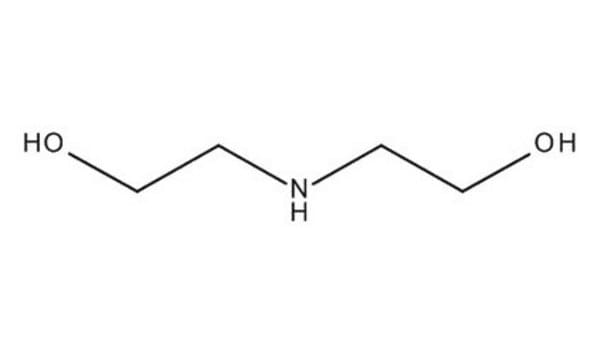1.16205
Diethanolamine
for analysis EMSURE®
Synonym(s):
Diethanolamine, ß,ß′-Dihydroxydiethylamine, Bis-(ß-hydroxyethyl)-amine
About This Item
Recommended Products
vapor pressure
<0.01 hPa ( 25 °C)
Quality Level
product line
EMSURE®
Assay
≥99.5% (GC)
form
solid
autoignition temp.
365-370 °C
potency
676 mg/kg LD50, oral (Rat)
8328 mg/kg LD50, skin (Rabbit)
expl. lim.
2.1-10.6 % (v/v)
impurities
≤0.0001% Fe (Iron)
≤0.0001% Heavy metals (as Pb)
≤0.0005% Chloride (Cl)
≤0.002% Sulfate (SO4)
≤0.25% Water (Karl Fischer)
≤0.3% Ethanolamine (GC)
≤0.3% Triethanolamine (GC)
sulfated ash (600 °C)
≤0.005%
pH
11 (20 °C, 53 g/L in H2O)
kinematic viscosity
357.2 cSt(30 °C)
bp
269-270 °C/1013 hPa
mp
28 °C
transition temp
flash point 176 °C
density
1.09 g/cm3 at 30 °C (liquid)
storage temp.
2-30°C
InChI
1S/C4H11NO2/c6-3-1-5-2-4-7/h5-7H,1-4H2
InChI key
ZBCBWPMODOFKDW-UHFFFAOYSA-N
Looking for similar products? Visit Product Comparison Guide
Related Categories
General description
Analysis Note
Identity (IR-spectrum): passes test
Melting point: 26 - 28 °C
Chloride (Cl): ≤ 0.0005 %
Sulfate (SO₄): ≤ 0.002 %
Heavy metals (as Pb): ≤ 0.0001 %
Fe (Iron): ≤ 0.0001 %
Ethanolamine (GC): ≤ 0.3 %
Triethanolamine (GC): ≤ 0.3 %
Sulfated ash (600 °C): ≤ 0.005 %
Water (according to Karl Fischer): ≤ 0.25 %
Legal Information
Signal Word
Danger
Hazard Statements
Precautionary Statements
Hazard Classifications
Acute Tox. 4 Oral - Eye Dam. 1 - Repr. 2 - Skin Irrit. 2 - STOT RE 2 Oral
Target Organs
Kidney,Liver,Blood
Storage Class Code
11 - Combustible Solids
WGK
WGK 2
Flash Point(F)
280.4 °F - closed cup
Flash Point(C)
138 °C - closed cup
Certificates of Analysis (COA)
Search for Certificates of Analysis (COA) by entering the products Lot/Batch Number. Lot and Batch Numbers can be found on a product’s label following the words ‘Lot’ or ‘Batch’.
Already Own This Product?
Find documentation for the products that you have recently purchased in the Document Library.
Customers Also Viewed
Related Content
Our ergonomic 1 L HDPE bottle for acids, bases, and solvents provide an alternative to glass chemical bottles for lab safety in pouring & handling of hazardous chemicals in the laboratory.
Our team of scientists has experience in all areas of research including Life Science, Material Science, Chemical Synthesis, Chromatography, Analytical and many others.
Contact Technical Service













